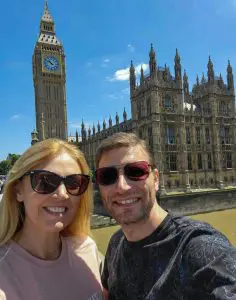 For those of you who don’t know (which probably isn’t many), London is the capital of England and because of that it has a rich and varied history. For many travellers it is a big tick on their bucket lists because it incorporates everything you want to see, including iconic landmarks, interesting things to do and of course a royal family. But travelling to a capital can be costly when you add up flights, hotels, food, drink, and the attractions. We would always recommend attraction passes for your first visit to any major city, because they tend to be worth the cost. If you’re considering a pass, then check out the Go City London Card.
For those of you who don’t know (which probably isn’t many), London is the capital of England and because of that it has a rich and varied history. For many travellers it is a big tick on their bucket lists because it incorporates everything you want to see, including iconic landmarks, interesting things to do and of course a royal family. But travelling to a capital can be costly when you add up flights, hotels, food, drink, and the attractions. We would always recommend attraction passes for your first visit to any major city, because they tend to be worth the cost. If you’re considering a pass, then check out the Go City London Card.
For those of you looking to save a few pennies then you’ll be interested to know what you can see in London for free? Yes, there is quite a bit to see and do, so let’s begin with our best free attractions in London. This list is in no particular order because in all honesty, everything we’ve added is pretty great.
Ad Disclaimer!
This website uses paid adverts and affiliate links, these come at no additional cost to you and help us to fund the operation of the website, meaning we can continue to provide you with valuable content.
The money received from these links and adverts do not influence any recommondations made within our content.
Page Contents
Free Things to do in London
Tower of London
Ok, so we’ll start with a disclaimer that if you want to go into the Tower of London you will have to pay. But the most beautiful part of this attraction is the sight of the Palace itself. Because of that it’s a must for anyone visiting London, even if you cannot afford to actually enter this incredible fortress.
So, what is the Tower of London and why is it one of the Top 10 London Attractions? It is a World Heritage Site found on the north bank of the River Thames and is His Majesty’s official Royal Palace and Fortress. If you’d like a little history then it was founded towards the end of 1066 and the white tower which gave the spot its name, was built in 1078.
As well as a palace, most of you will know that the castle in the Tower of London was also used as a prison. Notable prisoners within the tower are:
- King John of Scotland
- William Wallace
- James I of Scotland
- Princes in the Tower
- Anne Boleyn
- Catherine Howard
- Lady Jane Grey
- Sir Walter Raleigh
- Guy Fawkes
- Rudolf Hess
- Kray Twins
Yes, even the Krays spent a short period of time within the walls of this grand palace in 1952.
The ex-royal residence consists of several buildings within two concentric rings of defensive walls and a moat. What makes it such a prominent attraction to visit is the role that the Tower of London has played in English History. As well as holding notable prisoners, it was besieged a number of times, served as an armoury, treasury, menagerie, home of the Royal Mint and is also home of the Crown Jewels of England.
Because the Tower of London is so big, you’ll get your best views of it on Tower Bridge, or across the bridge on the south bank of the river Thames. From these spots you’ll get that distance view of the towers and defensive walls. By heading over and taking a closer look you can see the moat and gates, which are impressive. There was plenty to see including statues of lions and beautiful flower beds which really add to your Tower of London pictures.
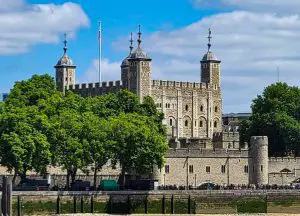 Our first view of the Tower of London was at night-time during a Thames River cruise, and it was a sight to behold. They light it up at night which gives it quite a menacing look, as you would expect with a place which has seen so much death and torture.
Our first view of the Tower of London was at night-time during a Thames River cruise, and it was a sight to behold. They light it up at night which gives it quite a menacing look, as you would expect with a place which has seen so much death and torture.
Of course, it would be amazing to go inside and see the Tower of London itself, but if you don’t have the time or money then make sure you at least go to visit and take a walk around the site.
Free London Museums
London is known for having some of the world’s greatest museums and the sheer quantity of them could keep you busy for a couple of weeks at least. What you may not know is that many of the museums in London are free. So here is our list of free London museums and a little introduction into what they are about.
- British Museum – This is very similar to major museums in other capitals in that they exhibit a vast spectrum of historical eras such as Ancient Egyptian, Greek and Roman. There is a little British history included for those of you interested solely in that, but the whole museum provides us with a glimpse of the past and how we got to be where we are today. Yes, this is a free museum, but there maybe special exhibits which have an additional fee charged.
- Natural History Museum – There are many Natural History Museums in the world, but this one is quite beautiful and can be found in South Kensington’s free museum district. Themed on the many elements of the Earth such as geology, this is a wonderful exploration into the place we lovingly know as home.
- The Science Museum – This collection shows the technological advancements made over the years by humans and covers an array of areas such as space travel, transport, engineering, and photography. There’s even a Wonderlab area which provides hands-on experiments for kids to play and learn. The Science Museum can also be found in the South Kensington Museum area.
- Victoria and Albert Museum – Another South Kensington Museum, this beautiful building houses over 5,000 years of art and design. Of course, this can cover an array of subjects, so you can expect to see sculptures, clothing, jewellery, and illustrations. There are so many topics covered in this museum, you’ll find your senses are overwhelmed. The great thing is you can visit as often as you like because it is free.
- Museum of London – If you want to learn about one of the greatest cities in the world then where better to discover its rich history, than in the Museum of London. This museum explores a number of eras within London’s steeped history, such as the Roman influence, the Great Fire of London, Medieval London and even what was on the land before the city was built.
- Museum of London Docklands – Connect to the Museum of London is the Museum of London Docklands which provides additional history into the area from the viewpoint of a Londoner and explores its heritage as a port city. Exhibits are based on the docklands and rivers and delve into how trade grew in the area and the impact that had on London.
- Imperial War Museum – It’s probably a little self-explanatory, but the Imperial War Museum provides an in-depth look into the many wars over the centuries. Of course, it heavily focuses on WW1 and WW2, especially because of the impact they had on London during the Blitz. You will find plenty of exhibits and artifacts, plus videos which help explain what it was like during the conflicts.
- Design Museum – This is another museum with a broad spectrum of collections from art to surrealism and even modern design. There are paid exhibits in the museum which they recommend you prebook.
- London Mithraeum – This is an archaeological site found under Bloomberg’s European Headquarters. It comprises of an ancient temple and Roman artifacts which were discovered during recent excavations. Originally Londinium was founded by the Romans, and they made their home on a lost river called the Walbrook. Nearly 200 years later a temple to the god Mithras was built next to the river and this temple was discovered in 1954 during the clean up of a post-war London.
- Barbican Conservatory – Is a building which is home to over 1,500 plants and trees which are rare or endangered in their natural habitats. This provides visitors with the chance to see unusual flora from rocky deserts, the bushland of South Africa, or even the coastline of Brazil. Within the large green house, you’ll find three pools with a variety of fish including Koi carp.
- Tate Britain – This gallery displays art made in Britain and visiting their extensive collection is completely free. They do have exhibits on specific artists on occasion but generally you will see a myriad of paintings shown in chronological order from some of Britain’s greatest artists.
- The National Maritime Museum – As you can imagine this is a museum with a focus on the nautical. With various exhibitions on London’s seafaring past, it’s also a great spot to take the kids because they have fun play areas for them.
- National Army Museum – With a focus on the British armed forces, the museum covers an array of areas including specifics about wars that have been fought.
We warned you there was a lot of free museums, so even if you don’t fancy all of them, hopefully we have provided you with enough information to pick a few. We are personally big fans of the Imperial War Museum and the Science Museum.
London Bridges
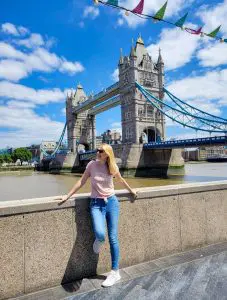 London is pretty famous for its bridges, especially when you consider that there’s a nursery rhyme specially named after one of them (London Bridge is Falling Down – for those who aren’t sure). So, it would make sense that you tick off seeing these popular London bridges when you visit. There are 35 bridges which cross over the river in London, but we’re going to focus on our favourites, which as you can imagine are all free to see.
London is pretty famous for its bridges, especially when you consider that there’s a nursery rhyme specially named after one of them (London Bridge is Falling Down – for those who aren’t sure). So, it would make sense that you tick off seeing these popular London bridges when you visit. There are 35 bridges which cross over the river in London, but we’re going to focus on our favourites, which as you can imagine are all free to see.
- Tower Bridge – The most famous of them all and rightfully so, as it is truly an iconic London sight. This bridge was completed in 1894 and can be found near the Tower of London and HMS Belfast. We loved the views of the bridge from the south bank, but it was also pretty amazing to see both Tower Bridge and the Tower of London together. Imagine that perfect Instagram picture! If you want to see more, there is a behind the scenes tour of the bridge but that will have an additional charge. It goes into the machinery and hydraulic systems used to make the bridge rise which allows for river traffic.
- London Bridge – Found close to Tower Bridge is the famous London Bridge, although don’t be too disappointed when you see it. It’s not as flashy as Tower Bridge and in all honesty is pretty bland when compared to many of the others in London. But if you want to tick off London’s famous top bridges then it’s a must.
- Millennium Bridge – Close to Shakespeare’s Globe, the Millennium Bridge opened in 2000 and offers a modern design named the ‘blade of light’. It was given the nickname by locals of the ‘wobbly bridge’ due to the swaying motion felt on opening day. That was fixed immediately, but the name has stuck around.
- Westminster Bridge – Another iconic bridge to both stand on and to see, because right next to it is the Palace of Westminster. You can see the same design features in the bridge as there are in Westminster itself. From that spot you can also see Big Ben and the London Eye, but what really makes it a bridge worthy of visiting, is that it’s the oldest road bridge in central London.
Houses of Parliament
For those of you who don’t know, the Palace of Westminster is where both the House of Commons and House of Lords meets, which are the two houses of Parliament for the United Kingdom. Most of us know Westminster as the Houses of Parliament and it is one of the iconic photo stops that tourists take when they visit London.
The design of the Palace of Westminster is a Perpendicular Gothic style which was popular in the 15th century and it’s this architecture which makes it stand out. Most visitors love to head to the south bank side of the river Thames to get a picture of Westminster Palace and the bridge.
If you’re a UK resident and looking for a peek inside, then you can request a free guided tour. Head to the Parliament.UK website and find your local MP or Member of the House of Lords. You can then contact them and place a request to have a tour. The site says you do not have to know your MP personally or support them politically to book the tour.
It’s a 75-minute tour which explains the work of the UK Parliament and its relevance today. The representative will also explain what each area is used for and explore the history of the Palace of Westminster. You can also visit public galleries and attend debates where MP’s and Peers question the government on the current issues of the day.
If you’re a non-UK resident then you can still tour the Palace of Westminster, but sadly there is an additional cost.
Buckingham Palace
For anyone planning a first trip to London, one of the most iconic places to visit will be Buckingham Palace. You’ll probably be aware that it is the royal residence and administrative headquarters of the monarch of the United Kingdom. Buckingham Palace has such historical significance because it is the main spot of national rejoicing and mourning.
Not to ruin the surprise, but we felt that the Palace was much smaller than we expected; to be fair we felt the same about the White House in Washington. The original section of the palace was built in 1703 by the Duke of Buckingham and it was known as Buckingham House. It was bought by King George III in 1761 as a private residence for Queen Charlotte. Over the years the building was enlarged with three wings being added and it was here it became the Royal residence known as Buckingham Palace.
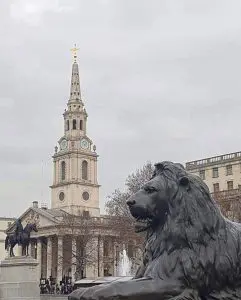 Sadly, if you want to visit Buckingham Palace you will need to pay, and it’s not exactly cheap. So, if you’re looking to keep things low cost then simply enjoy the fact that you’re near this historical masterpiece and grab those perfect vacation pictures. There are security railings in front of the palace, but you can get some great pictures throughout the mall (which is the area leading up to Buckingham Palace).
Sadly, if you want to visit Buckingham Palace you will need to pay, and it’s not exactly cheap. So, if you’re looking to keep things low cost then simply enjoy the fact that you’re near this historical masterpiece and grab those perfect vacation pictures. There are security railings in front of the palace, but you can get some great pictures throughout the mall (which is the area leading up to Buckingham Palace).
Every morning during the summer at 11.00am and every second morning during the winter, you can witness the Changing of the Guard. But we’ll delve into what that entails a little further in our guide.
If you’re hoping to catch a glimpse of royalty, then keep an eye out for the flags above the palace. If the Royal Standard is flying then that is an indication that a Sovereign is present, but if it’s the Union Jack instead then they are not.
Trafalgar Square and the Lions
Although it’s simply a public square in London, Trafalgar Square is another top item on peoples bucket lists. The square was built to commemorate the Battle of Trafalgar, which is why you’ll see a statue of Admiral Nelson above the 169-foot Nelson’s Column. Around the column are four bronze lion statues who are said to guard Nelson and every Christmas they display a tree gifted from Norway.
Most of the time the square is used as a tourist attraction or a place to sit and watch the world go by. But it’s also known to have been the spot for many protests and demonstrations.
Is Trafalgar Square worthy of being added to your bucket list? Yes of course, it’s quintessentially London and because of its location being quite central, then it’s the perfect spot to help get your bearings.
Red Telephone Box
This is a bit of a strange one because it’s not specifically an attraction, but it is an important thing to see when you visit London. Red telephone boxes have become a pop culture phenomenon, with popular artists capturing them in their pieces, or epic movies such as the Harry Potter series using them as a portal to the Ministry of Magic.
Although the number of boxes has significantly reduced due to the introduction of mobiles, there’s still plenty of them dotted around London. Our favourite one can be found on Great George Street near Parliament Square, because not only do you get the phone box in your picture, but you will also see Big Ben in the background. Because it’s such a great photo spot you may see a queue of people waiting to get a picture. But it will be worth the wait and why not help each other out and take pictures for other travellers as you queue.
Be sure you add it to your bucket list to make your Insta followers jealous of your epic adventures.
Changing of the Guard
If you’ve read all the way through this guide, then you’ll know we mentioned the Changing of the Guard within the Buckingham Palace section. This formal ceremony has sentries performing their ceremonial guard duties as they are relieved by a new batch of sentries. The ceremony is performed by the King’s Guard and is an elaborate choreographed performance which the public can watch for free.
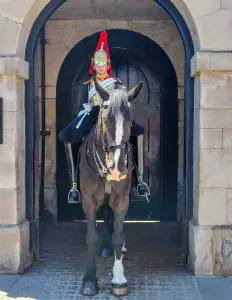 The King’s Guard are tasked with protecting the Royal residences in London and Edinburgh. To see this military ceremony, you will want to head to Buckingham Palace. It will occur at 11.00am daily through the summer and every other day in the winter months, but it’s always best to check out the schedule online before you head over.
The King’s Guard are tasked with protecting the Royal residences in London and Edinburgh. To see this military ceremony, you will want to head to Buckingham Palace. It will occur at 11.00am daily through the summer and every other day in the winter months, but it’s always best to check out the schedule online before you head over.
The march of the old guard will last for approximately 45 minutes, with musical backing from a Regimental Band. To help you enjoy the experience we prewarn you, don’t get in the way of the march. During the ceremony you will normally hear a guard shouting ‘make way for the King’s Guard’. Heed their warning and move away because they will not stop or march around you and you may be pushed to the side. Police Officers are normally present during the ceremony to ensure everyone remains safe.
The Changing of the Guard happens in three locations, which are Buckingham Palace, St James’s Palace and Wellington Barracks. The ceremony goes as follows.
- The St James’s Palace detachment of the Old Guard gathers in Friary Court for an inspection by the captain.
- They then make their way down The Mall towards Buckingham Palace followed by the Regimental Band.
- The Old Guard on duty in Buckingham Palace are inspected whilst awaiting the arrival of the St James’s Palace detachment.
- The St James’s Palace detachment will enter the Palace forecourt and takes up their position in the grounds. The Old Guard will await the arrival of the New Guard in the Wellington Barracks.
- After the New Guard arrives, they will undergo their own inspection at the Wellington Barracks. A ceremony will be conducted by both the New Guard, Old Guard, and the Regimental Band. Part of this will see the Old and New Guards ‘Present Arms’ before the Captains of the Guard hand over the Palace keys. This act shows the transfer of responsibility from the Old to the New Guard.
- After the New Guards are posted, the Old Guard will leave the Palace grounds and march back towards the Wellington Barracks.
Things to consider if you want to watch the Changing of the Guards, is to make sure you get there early. Because it’s a popular attraction it can get pretty busy, so you want to make sure you get there early and pick a prime location near the Palace. Because it’s busy you may get thieves and pick pockets wandering about, so keep an eye on your wallets, purses, and bags as you watch the parade. We recommend heading to the Victoria Memorial or the gates of Buckingham Palace. If you’re not too bothered about the full ceremony, then you can head to The Mall or St James’s Palace.
The Changing of the Guard is the epitome of a London experience, so we highly recommend taking some time out of your day for it. It’s even more perfect that it’s free and you can take in the atmosphere with other travellers enjoying the experience.
Sky Garden
If you’ve spent the day pounding the streets of London and you’re looking for a little rest and refreshment, then why not visit the Sky Garden. It’s about a 10-minute walk from the tower of London, so it’s the ideal attraction for those of you looking for a break.
The Sky Garden can be found in the Fenchurch Building (known as the Walkie Talkie due to its unique shape) on the 43rd floor. It has floor to ceiling windows which provide panoramic views over the city of London. Within the room you will find beautiful, landscaped gardens which lead you through to the observation decks and an open-air terrace. Sky Garden is currently London’s highest public garden, and it was designed by architects Gillespies and installed by Idverde.
Of course, as you can imagine if it’s on this list then accessing the Sky Garden is completely free. Because there’s no charge it can get busy so they recommend that you reserve a ticket in advance, which you can do on their website. Visiting times vary depending on whether it’s a weekday, weekend or bank holiday, so it’s wise to check out their site to double check. They do recommend visiting at sunset because it’s a beautiful view.
If you fancy making it a bigger experience and you have the money, then why not visit one of Sky Gardens restaurants and bars. They even offer live music sessions and events such as sunrise yoga.
There are two restaurants in the Sky Garden and they are the Darwin Brasserie and Fenchurch.
- Darwin Brasserie – Offers a classic British menu in a relaxed atmosphere.
- Fenchurch – This is a fine dining eatery with a modern British menu which is the level above Darwin Brasserie.
You can just pop in for a drink instead, because Sky Garden has three bars including the Sky Pod Bar which hosts DJ nights. There is also the City Garden Bar and finally the Fenchurch Terrace which is ideal for grabbing a cocktail.
If you decide to visit then make sure you dress appropriately, because the garden is naturally ventilated so it can get cool.
Big Ben
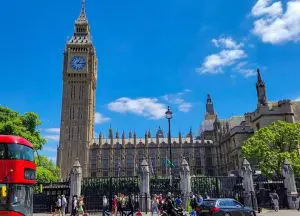 Big Ben is a British icon, and most visitors feel in awe when they spot it, even with the current works that are being undertaken. So, let’s start with a little history of what exactly Big Ben is. The term Big Ben is actually a nickname for what is officially known as the Great Bell of the Great Clock of Westminster. It can be found at the north end of the Palace of Westminster.
Big Ben is a British icon, and most visitors feel in awe when they spot it, even with the current works that are being undertaken. So, let’s start with a little history of what exactly Big Ben is. The term Big Ben is actually a nickname for what is officially known as the Great Bell of the Great Clock of Westminster. It can be found at the north end of the Palace of Westminster.
Designed by Augustus Pugin, it was completed in 1859 and given a neo-Gothic style which was similar to the other buildings in the area. The clock tower has been a Grade I listed building since 1970 and is a UNESCO World Heritage Site since 1987.
Now the great news is that you can visit Big Ben as a tour for free, but the bad news is that as we write this the tour isn’t available. Since 2017 they have been renovating Big Ben by adding a lift, reglazing and repainting the clock dials, upgrading lighting and repairing the roof tiles.
But those renovations won’t last forever, so make sure you check the website if you’re visiting because you may just be in luck. Because Big Ben is so symbolic for London, they have ensured that at least one clock face is visible to the public.
Alike Westminster, to tour Big Ben you have to be a UK citizen and request a tour from a member of parliament or the House of Lords. You must be over 11 years old and currently be able to walk 334 steps unaided, although this may change with the installation of a lift.
Should the tour still be closed when you visit, then you can always check out free tours, where you can discover the history of the clock and surrounding areas.
Push a Trolley at Platform 9 ¾ at Kings Cross Station
All Harry Potter fans know that King’s Cross station is where Harry and his classmates would take the Hogwarts Express to the school of Hogwarts. To access the platform, they needed to dash through a brick wall between platform 9 and 10, otherwise known as platform 9 ¾.
For those of you who enjoy some wizarding magic, you should head to King’s Cross station in London. Platforms 9 and 10 are separated by tracks, but there is a 9 ¾ on the station concourse. There you will see a luggage trolley embedded into the wall and it’s here you can take a picture as if you’re about to begin your journey to the incredible Hogwarts school.
You can pose with the trolley whenever you want and take free pictures, but if you fancy something more professional then they do have a photographer available between 9am and 9pm every day. If you forget your Hogwarts house scarf, then there is a Harry Potter shop within the station which is themed on Ollivander’s wand emporium and offers all sorts of merchandise.
What we love about attractions such as this is firstly, they’re free, and secondly, they don’t take up huge chunks of your day. Of course, school holidays and bank holidays can get busy so make sure if you visit during those times that you head there first.
Visiting King’s Cross for this experience adds a touch of magic to your day and is especially fun for kids and teens.
Walk the Thames River
The Thames is probably Britain’s best-known river, and it has a huge impact on tourist spots within London. It was used as a trade route, bringing essentials into London to sell and because of this you will find that many historic areas are built around the river. Major tourist attractions such as Westminster, the Tower of London and the London Eye can all be found next to the Thames. If you’re looking for a relaxed day to stroll, then why not take the river path and enjoy the views as you go. You will find that there’s a Thames River trail which makes it easier to meander along. Plus, as you’ve probably already worked out, it’s completely free.
Westminster Abbey
Westminster Abbey can be found in the City of Westminster and is styled as a Gothic abbey church. It’s widely connected to the Royal family and iconic events such as royal weddings. It’s one of the most famous buildings in the United Kingdom, so is a must see if you visit London.
Sadly, if you want to go inside the abbey as a tourist then there is a charge, because you will be given an audio guide so you can learn all about its history. As the Abbey is a working church, you will not be charged if you enter for worship and of course you can always enjoy the outside architecture.
All coronations of English and British monarchs have occurred within Westminster Abbey since William the Conqueror in 1066. There have also been sixteen royal weddings there since 1100, including Henry VII, the Queen Mother to her beloved Albert, Queen Elizabeth to Prince Phillip and Prince William to Catherine Duchess of Cambridge.
The Abbey is also a burial site of more than 3,300 people who are prominent in British history including a number of Kings and Queens, Sir Isaac Newton, Charles Darwin, Stephen Hawking and the tomb of the Unknown Soldier.
If you don’t want to spend the money to enter Westminster Abbey, then why not walk around it, take in the impressive architecture and grab a few photos; we promise you it’s worth it.
Piccadilly Circus
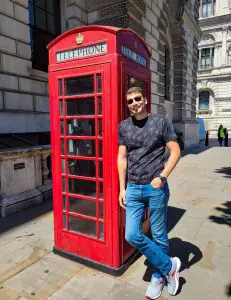 This road junction connects Piccadilly, Regent Street, Shaftebury Avenue, the Haymarket, Coventry Street and Glasshouse Street. The best way to describe Piccadilly Circus is a smaller version of Time Square in New York. The allure of Piccadilly Circus is the fact that it is close to the major shopping and entertainment within the West End.
This road junction connects Piccadilly, Regent Street, Shaftebury Avenue, the Haymarket, Coventry Street and Glasshouse Street. The best way to describe Piccadilly Circus is a smaller version of Time Square in New York. The allure of Piccadilly Circus is the fact that it is close to the major shopping and entertainment within the West End.
Alike Time Square there are plenty of neon signs and video displays placed on buildings around the circle. Combine the lights and the busy traffic and you’ll soon see why this spot is a highly visited tourist attraction. Similar to some of the other attractions on this list it is a relatively quick one to do, but we would recommend visiting in the day and at night so you can see it all lit up.
Paddington Bear Statue
For the Paddington Bear fans you will be excited to discover that within Paddington Station you can pose with the bear from Peru. Near the station clock on platform 1 is a life-sized bronze statue of our favourite bear which was designed by sculptor Marcus Cornish.
The statue is said to be found where Mr and Mrs Brown found Paddington when he first arrived in London. So, head over and grab a few pictures with our British National Treasure.
Wellington Arch
Wellington Arch was the original entrance to Buckingham Palace, but it has since become a victory arch for Wellington’s defeat of Napoleon. You can go into the arch and check out the views from the top, but you would have to buy tickets via English Heritage. So why not take in the sights of the beautiful arch and the Quadriga, which is the four horsed chariot sculpture from the ground.
The arch is a Grade I listed triumphal arch which is said to be the centre piece of Hyde Park Corner. It’s a great spot for watching the King’s Guards as they pass through each day as part of the Changing of the Guards at Buckingham Palace.
Smaller Free Attractions for your London Bucket List
Sherlock Holmes Statue and Baker Street
If you’re a Sherlock Holmes fan, then you’ll probably be looking at heading to the famous Baker Street. Our first suggestion would be to go outside Baker Street tube station where you can find a statue of the great detective himself. Then once you’ve posed and taken pictures, you can take a short walk around the corner to 221b Baker Street, which was the home of Sherlock Holmes. There is a museum on the site, but as you can imagine there is an entrance fee.
Covent Garden Street Entertainers
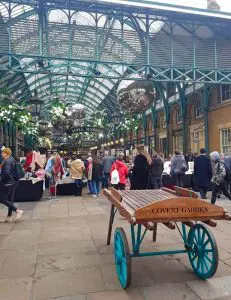 Most Londoners know Covent Garden as a great spot to stop for food and drink, but this former fruit and vegetable market is now a popular tourist attraction. Covent Garden is a district in London but it’s the market in the central square we’ll focus on.
Most Londoners know Covent Garden as a great spot to stop for food and drink, but this former fruit and vegetable market is now a popular tourist attraction. Covent Garden is a district in London but it’s the market in the central square we’ll focus on.
The central building opened as a shopping centre in 1980 and is the ideal spot to wander around quaint shops, cafes, pubs, and a craft market. We’ve stopped for food and drinks a number of times and just adore the chilled atmosphere.
Around the market you’ll find plenty of photo opportunities for your Instagram page, especially at certain times of the year such as Christmas. Covent Garden is known for its street performers including mime artists, sword swallowers, jugglers, and magicians. This means you can enjoy free entertainment whilst enjoying a break from the hustle and bustle of London life.
Twinnings Tea Shop
For most Brits, a good old cup of tea makes life great, and we drink it by the gallon. So of course we’d have a tea shop on our free attractions list. Twinning’s is a popular brand in the UK with over 300 years of history. The London Twinning’s store is their flagship store so you can expect an incredible tea experience.
To begin they offer tea experiences and masterclasses, but as you can imagine they will cost you extra. If you’re looking for freebies, then head to their premium sampling bar where you can try a selection of their loose-leaf teas and infusions. Then if you want to buy any, you can head to their pick and mix wall to create your personalised selection.
As well as it being a shop, there is an area which is dedicated to the history of Twinning’s, so you’ll have the opportunity to discover why notable customers such as Jane Austen loved a brew.
Chinatown London
You will find Chinatown close to Leicester Square, so it’s pretty much in the centre of the capital. This area is sensory overload because it provides beautiful architecture, bustling shops and lots of food spots and restaurants.
If you’re happy to spend a bit of money, then why not try some of the incredible Asian cuisine which can be found in Chinatown. But if you want to keep your pennies, then simply wander around and take it all in. There are plenty of lanterns strung from the four ornate gates which symbolise your entrance into the Chinatown area. Each is different in style, but they are equally beautiful and are intricately designed as a homage to China.
Harrods
Harrods is one of the most renowned stores in the UK and many tourists pop in to simply say they’ve been. Although we have to prewarn you, it is huge! Charles Harrod opened the original store in 1834 as a wholesale grocery but over the years he expanded it by purchasing the buildings nearby.
Everything about Harrods is extravagant from its décor which includes statues and fountains, to its clothing which is all designer brands. It’s the perfect stop if you’re looking to get out of the rain, or you fancy seeing how the other half live.
Abbey Road Beatles Crossing
One of the most iconic album covers has to be Abbey Road by the Beatles which shows the famous four walking over a zebra crossing. As you can imagine that crossing is still there and is visited by tourists every day. In fact it’s so iconic they have recreated the crossing at The Beatles Story in Liverpool.
The Beatles arrived at Abbey Road recording studios in April 1969 to make their final album. Since then both the zebra crossing, and studio have become a famous spot for Beatles fans worldwide. You can replicate the Abbey Road album cover with your friends but remember that you are crossing a road which is in constant use, so be safe.
Nearby the crossing is Abbey Road studios and although they don’t currently offer tours you can take a picture outside. Many famous bands and artists have recorded there including Pink Floyd and Adele. There is a little souvenir shop for you to browse in if you’re looking for a keepsake.
The Old Curiosity Shop
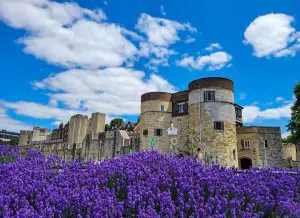 This little building can be found near the London School for Economics and could easily be missed. But we would recommend you take a moment to check it out because as well as being beautiful it is said to have inspired the Dickens novel of the same name.
This little building can be found near the London School for Economics and could easily be missed. But we would recommend you take a moment to check it out because as well as being beautiful it is said to have inspired the Dickens novel of the same name.
The building dates back to the 16th century and is one of London’s oldest shops, so that alone makes it a worthy stop. Charles Dickens is said to have visited the shop on a number of occasions.
Peter Pan Statue
Within Kensington Gardens is a bronze statue of J.M. Barrie’s famous character Peter Pan, the boy who would not grow up. It was commissioned by Barrie and placed there in 1912, in the same spot where Peter lands his bird-nest boat in the story ‘The Little White Bird. It’s a great photo opportunity and we’re sure the young at heart will love to see this famous character brought to life by the man who created him.
London’s Lilliputian Police Station
If you’re heading to Trafalgar Square, then make sure you keep an eye out for London’s smallest Police Station which can be found on the southeast corner. At first glance it kind of looks like a Tardis, but you’ll be interested to know that it was built in the 1920’s as a watch post. During that time there were lots of protests and riots which all culminated back to Trafalgar Square. So, a small police station was devised which had a direct line to Scotland Yard if things got out of hand. Inside you can only fit one police officer and it has castle-style slits which allows the officer to watch in safety. If the officer picked up the phone, then a light on top of the building would flash and inform people that back up was on the way.
Sadly, today this historical monument is no longer used by the police and is instead a storeroom for cleaners.
Carnaby Street
There is a long history in Carnaby Street, from it being the location of plague houses to the epicentre of the swinging 60s and home to the new wave of fashion in the 80s. Most people have heard of this little piece of the London West End.
Carnaby covers an area of 14 streets, and you’ll know when you’ve arrived because there is a sign welcoming you. You will find a number of global brands dotted around as you wander the quaint streets. But what makes this the Carnaby Street that people love are the tiny boutiques, bespoke jewellery designers and one-off businesses. It’s the drive for originality which made this spot so famous in the first place.
The Ruins of St. Dunstan-in-the-East
The church of St. Dunstan-in-the-East is an interesting place to visit, and it can be found close to the Tower of London. Sadly this 900-year-old church is in ruins after being a casualty of the London Blitz. This wasn’t the only time it was damaged by a historical event because it was also burnt down by the Great Fire of London in 1666. Now the ruins are a beautiful public garden, with flowers, ivy and trees growing amongst the arches of the buildings shell. It’s seen as memorial to the Blitz and the resilience of Londoners.
Goodwins Court
Have you ever fancied visiting Diagon Alley from the Harry Potter books? Well, Goodwins Court is said to be the inspiration for the magical street. This interesting side street allegedly appeared in the Survey of London in 1690 and when you arrive you will see why it’s quintessentially old London. From the fronted bay windows to the still used gas lamps, if you don’t feel like you’re in a Dickens novel then you’re doing it wrong.
Many tourists miss Goodwins Court because you have to walk through a low roofed arch off St Martin’s Lane. But if you’re looking for some London nostalgia then we would highly recommend it and remember it’s free.
London Wall
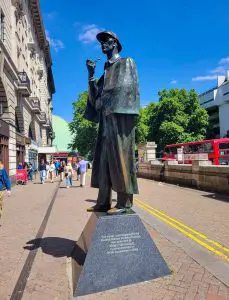 Right near the Tower of London is the London Wall which is a surviving section of a wall built around 200 AD. It was a defensive wall built by the Romans to protect them from any danger. It not only provided defence for London citizens, but it was seen to be a representation of the growing city.
Right near the Tower of London is the London Wall which is a surviving section of a wall built around 200 AD. It was a defensive wall built by the Romans to protect them from any danger. It not only provided defence for London citizens, but it was seen to be a representation of the growing city.
The Mayflower Pub
The history fans will enjoy this one, because the Mayflower Pub is said to be the oldest pub on the Thames. It is your atypical traditional English pub but with one exception, outside is the original 1620 moorings of the Pilgrim Father’s Mayflower ship. So, as you enjoy a tipple or two you can sit in the same spot as some of the founders of America.
Allies Sculpture
Not far from Piccadilly Circus is a bronze sculpture called the Allies, which was created to celebrate the relationship between Churchill and Roosevelt. You can share a bench with these two heroes who seem to be chatting amiably. The statue was unveiled in 1995 to commemorate 50 years of peace.
Tyburn Tree Marker
We’ll begin by saying that Tyburn Tree wasn’t actually a tree, it was a site of public hangings. The marker which is surrounded by 3 trees is dedicated to the sad history. Hangings began as early as 1108, but it was 1571 when the wooden scaffold was erected. It’s hard to imagine but public hangings were actually quite popular and drew crowds of families.
London Free Attractions Summary
So, there you have it, we realise it’s a pretty extensive list, but London has a wealth of history as well as being a huge city. The likelihood is you won’t be able to tick everything off this list, but many of the items are near each other and they’ll only take a few minutes of your time.
Our advice for London is to make use of the Tube, it’s simple to work out and will save you having to walk everywhere.
Having free attractions on your list when you travel is always a good idea, because many cities, especially capitals can be incredibly expensive. We have done a guide on the best free attractions in Paris for anyone thinking of booking their next trip. But we really hope you enjoy your time in London and remember to take plenty of pictures and tag us in on Instagram; we love to see what you’ve been doing.